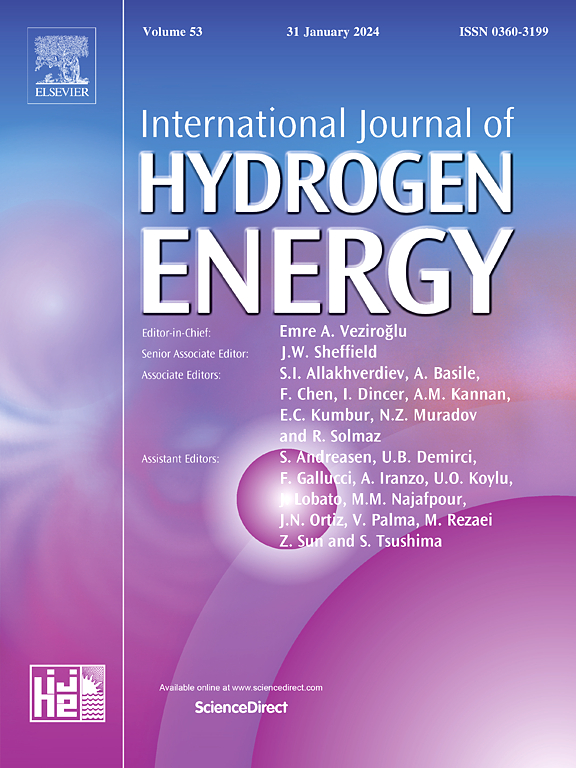生物质和废物气化过程中焦油转化为富h2合成气的最新进展:利用原位方法
IF 8.1
2区 工程技术
Q1 CHEMISTRY, PHYSICAL
引用次数: 0
摘要
生物质废物(BMW)和城市固体废物(MSW)气化的一个主要障碍是焦油的形成,这是一种不可避免的副产品,会降低能量转换效率并污染下游系统。沥青可通过原位或非原位方法处理。虽然非原位方法因其效率和易于控制而被广泛研究,但原位方法具有改善质量和热量传递、能源自给自足和降低基础设施成本等优点。通过原料选择、优化条件和催化升级将焦油转化为高价值的燃料和化学品是一种有效的策略,催化剂在提高产品选择性方面起着关键作用。本文综述了通过原料选择和反应优化对BMW/MSW焦油进行升级的最新进展,重点介绍了将焦油转化为增值燃料的单金属(Ni, Fe)和双金属(Ni - Fe, Ni - co)催化剂的性能。来自多个研究的数据被汇编、分析,并以图表的形式呈现。值得注意的是,温度在气化过程中起着至关重要的作用,通过促进焦油裂解反应,不同的气化剂具有特定的临界温度,通常在700至900°C之间。超过这个范围,逆向水气转换反应(WGSR)可能占主导地位,减少H2的产量。单金属催化剂热催化焦油升级换代效率高,但在使用寿命试验中存在稳定性低、抗积碳性能差的问题。相比之下,双金属催化剂的稳定性比单金属催化剂提高了约3.5倍,并实现了95%以上的焦油转化为有价值的产品。尽管有这些进步,烧结和焦炭沉积仍然是重大的挑战,突出需要改进催化剂改性策略,以提高稳定性和活性。本文章由计算机程序翻译,如有差异,请以英文原文为准。
Recent advances in tar conversion to H2-rich syngas during biomass and wastes gasification: Leveraging in-situ approach
A major roadblock in biomass waste (BMW) and municipal solid waste (MSW) gasification is the formation of tar, an unavoidable by-product that reduces energy conversion efficiency and contaminates downstream systems. Tar can be addressed through in-situ or ex-situ methods. While ex-situ approaches are widely studied for their efficiency and ease of control, in-situ methods offer advantages such as improved mass and heat transfer, energy self-sufficiency, and lower infrastructure costs. Converting tar into high-value fuels and chemicals through feedstock selection, optimized conditions, and catalytic upgrading is an effective strategy, with catalysts playing a key role in enhancing product selectivity. This review summarizes recent progress in BMW/MSW tar upgrading through feedstock selection and reaction optimization, with a novel focus on the performance of monometallic (Ni, Fe) and bimetallic (Ni–Fe, Ni–Co) catalysts for converting tar into value-added fuels. Data from multiple studies are compiled, analyzed, and presented in figures and tables. It is noted that temperature plays a crucial role in the gasification process by promoting tar cracking reactions, with different gasification agents having specific critical temperatures typically ranging from 700 to 900 °C. Beyond this range, the reverse water-gas shift reaction (WGSR) may dominate, reducing H2 production. Thermal catalytic tar upgrading with monometallic catalysts shows high upgrading efficiency but suffers from low stability and poor resistance to carbon deposition after a single use in lifetime tests. In contrast, bimetallic catalysts improve stability by approximately 3.5 times compared to monometallic catalysts and achieve over 95 % tar conversion into valuable products. Despite these advances, sintering and coke deposition remain significant challenges, highlighting the need for improved catalyst modification strategies to enhance both stability and activity.
求助全文
通过发布文献求助,成功后即可免费获取论文全文。
去求助
来源期刊

International Journal of Hydrogen Energy
工程技术-环境科学
CiteScore
13.50
自引率
25.00%
发文量
3502
审稿时长
60 days
期刊介绍:
The objective of the International Journal of Hydrogen Energy is to facilitate the exchange of new ideas, technological advancements, and research findings in the field of Hydrogen Energy among scientists and engineers worldwide. This journal showcases original research, both analytical and experimental, covering various aspects of Hydrogen Energy. These include production, storage, transmission, utilization, enabling technologies, environmental impact, economic considerations, and global perspectives on hydrogen and its carriers such as NH3, CH4, alcohols, etc.
The utilization aspect encompasses various methods such as thermochemical (combustion), photochemical, electrochemical (fuel cells), and nuclear conversion of hydrogen, hydrogen isotopes, and hydrogen carriers into thermal, mechanical, and electrical energies. The applications of these energies can be found in transportation (including aerospace), industrial, commercial, and residential sectors.
 求助内容:
求助内容: 应助结果提醒方式:
应助结果提醒方式:


